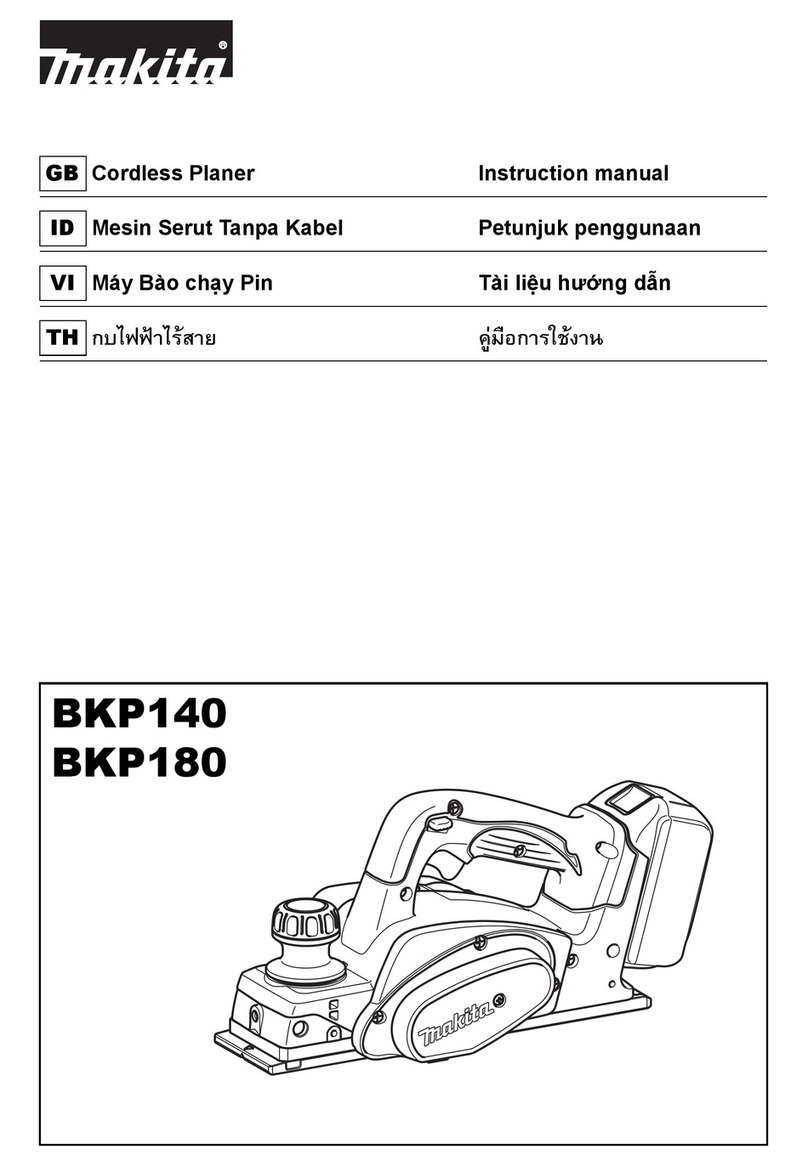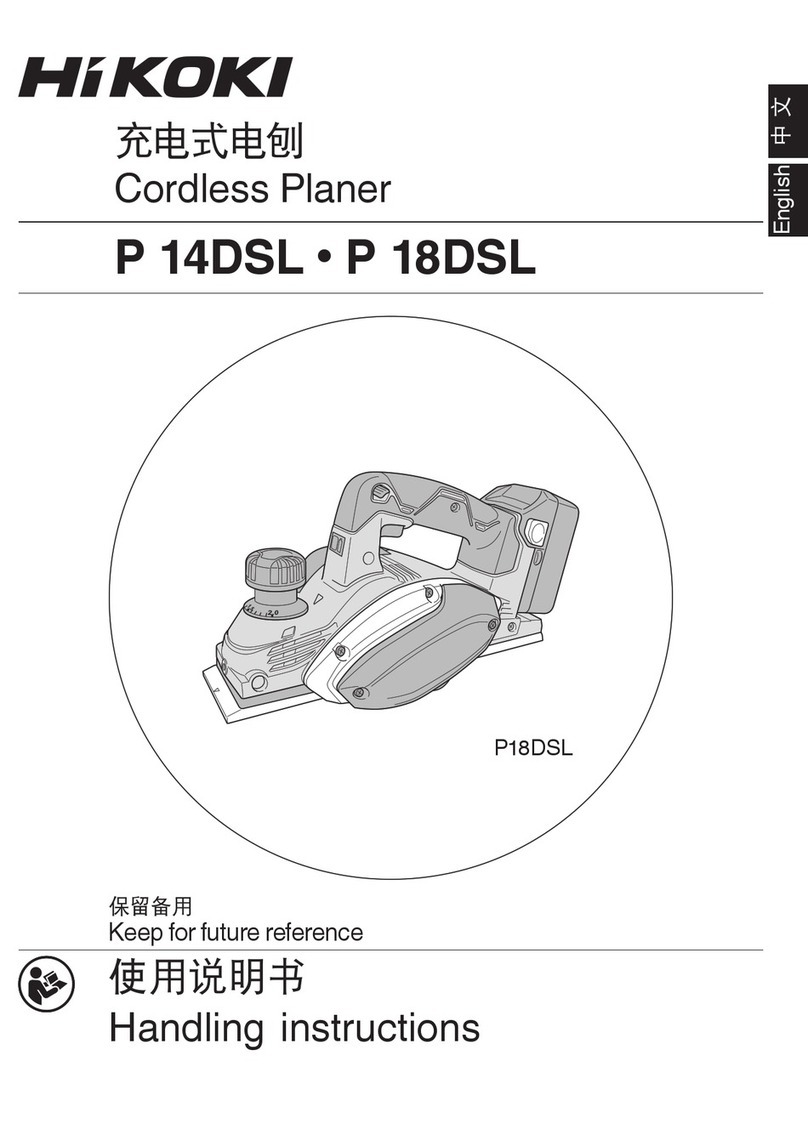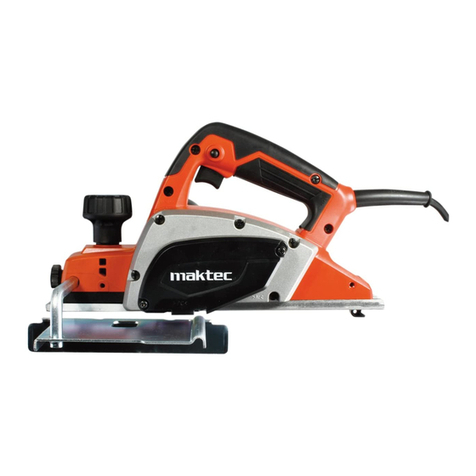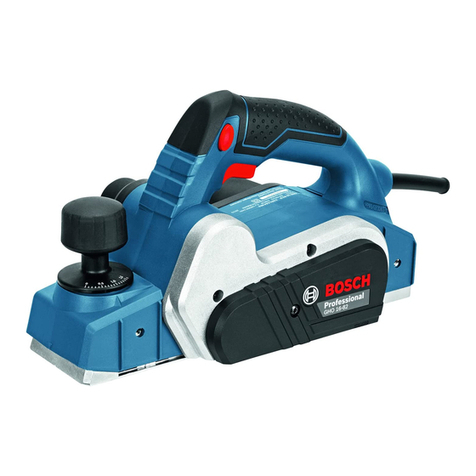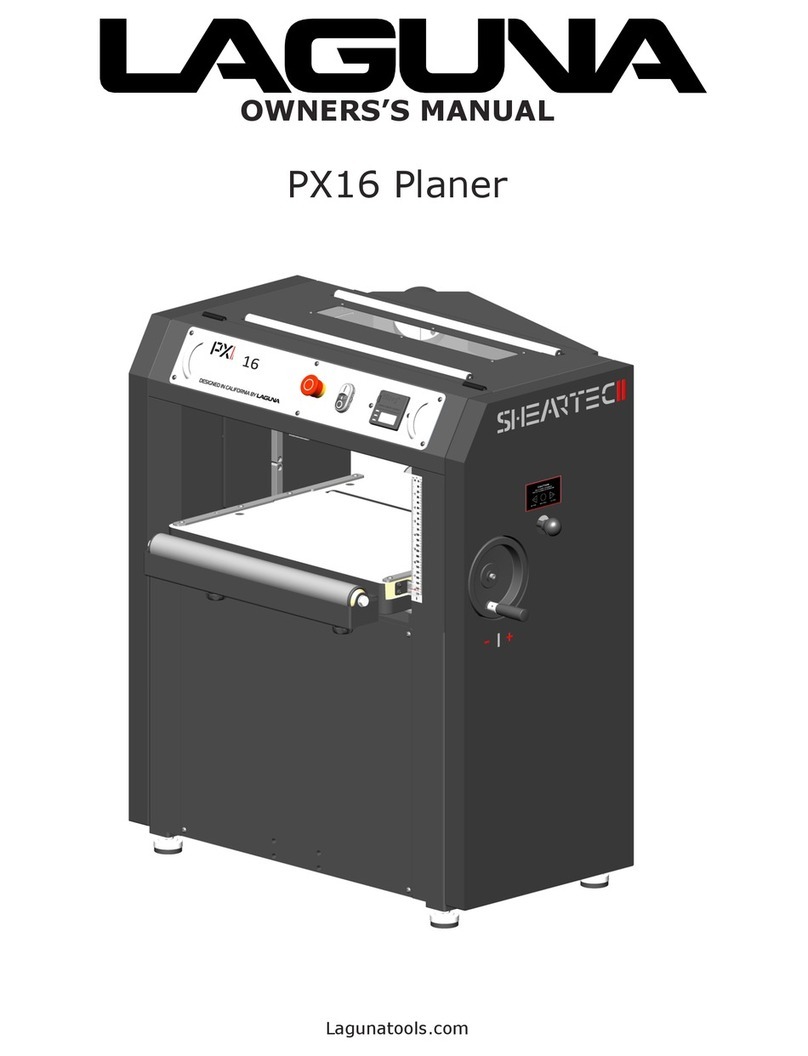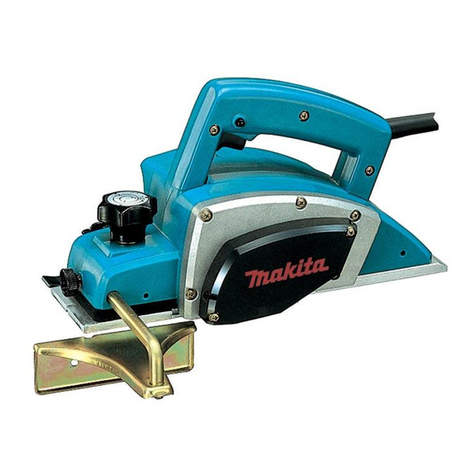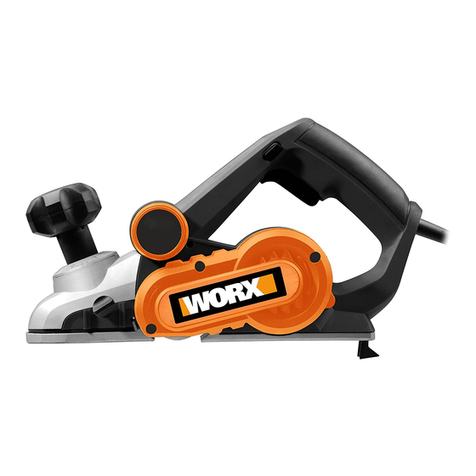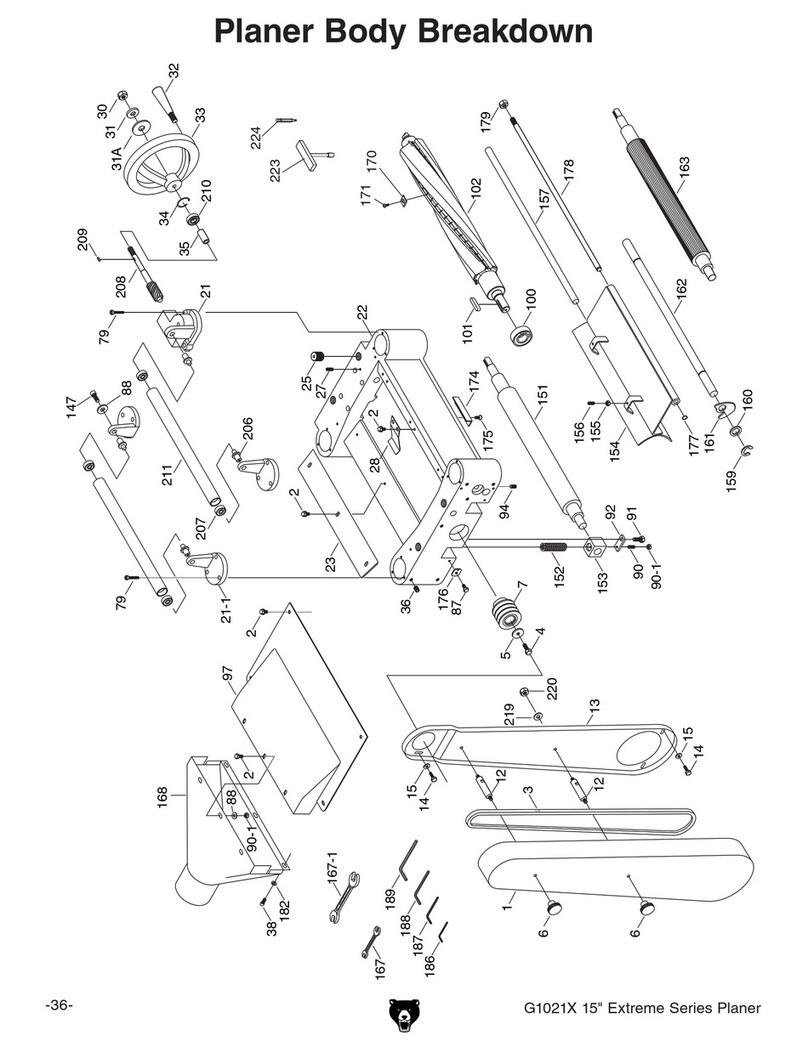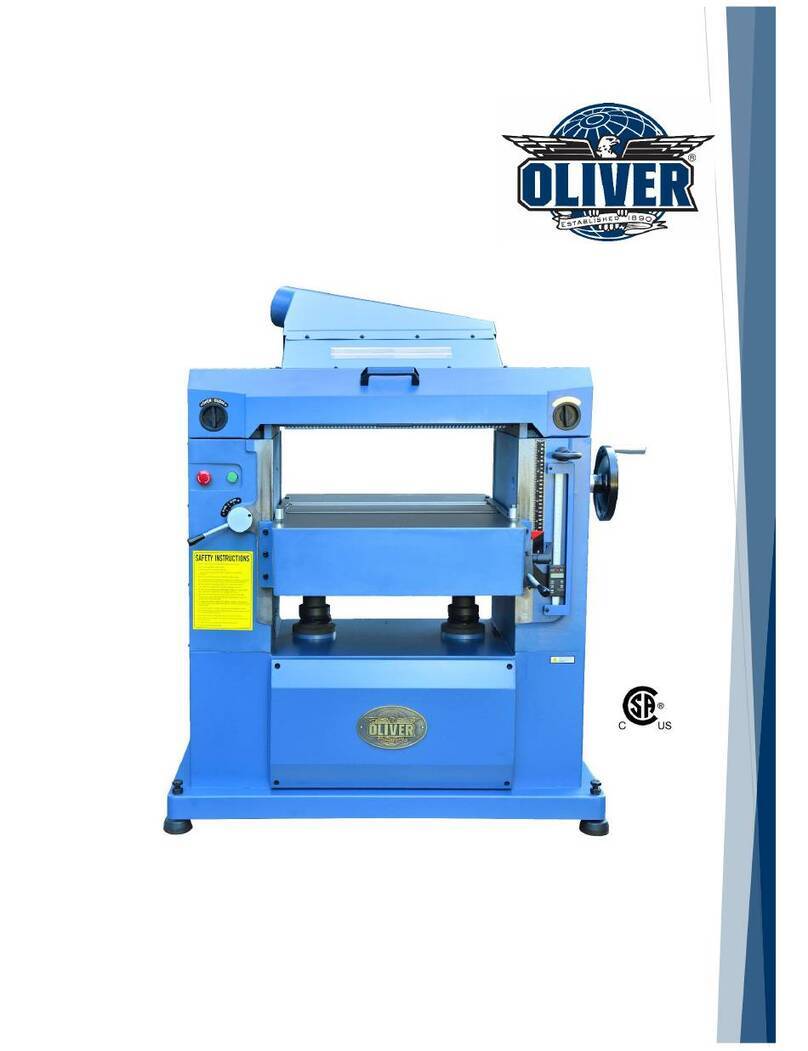SWISS TEC ST-330 TP User manual

1
Operator’s Manual
ST-330 TP
330MM PORTABLE PLANER
DKSH Hong Kong Limited
23/F Tower A, Southmark, 11 Yip Hing Street, Wong Chuk Hang, Hong Kong
www.dksh.com
100x10mm

2
CAUTION: Read and follow all Safety Rules and Operating Instructions before First Use of this
Product.
This manual provides important information on proper operation and maintenance. Every effort has
been made to ensure the accuracy of this manual. We reserve the right to change this product at any
time without prior notice.
SAVE THESE INSTRUCTIONS FOR FUTURE REFERENCE.
1 Handle Assembly 2 Carrying Band
3 Emergency/ ON/OFF Switch 4 Cover
5 Base frame 6 Rollers
7 Depth Ruler 8 Carbon Brush Holder
SPECIFICATIONS
Model No. ST-330 TP
Motor 230V~50Hz / 1500W
Cutting Width 330 mm
Cutting Thickness (max.) 152 mm
Cutting Depth (max.) 0,8 – 2,8 mm
No. of Blade 2
Rotating Speed 9500 min-1
Weight (Gross/Net) 35 kg / 33 kg
Working Table 330x235 mm
1
3
2
4
5
6
7
8

3
WARRANTY
To ensure the proper functioning of its products, to meet the best standards of quality, durability and to ensure the
consumer / retail customer that any of our products are of no defects in materials and operation of the DKSH
Group is committed as follows
1 YEAR WARRANTY ON ALL PARTS OF ELECTRICAL AND MECHANICAL
2 YEAR WARRANTY ON DEFECTS IN CONCEPT
This warranty will be invalid in case of misuse or abuse directly and indirectly, negligence, accidents, normal wear
and tear, repairs or modifications made by us or in case of lack of maintenance.
The warranty granted by the DKSH Group is limited to the period referred to above.
The warranty period is for an 8-hour daily operation. If you exceed this time frame, the warranty period is reduced
in proportion to the operating surplus, in each case up to a maximum of 3 months.
For the warranty to apply, you will need to send back for inspection by the product or part of it, prepaid, to an
authorized service center, established by our office. The goods must be accompanied by a document certifying
the purchase date and problem (invoice or receipt with a legible reported the item purchased, receipts will not be
accepted or illegible entries generic as "different", etc. where section 1 of course cannot be identify with certainty
the item purchased).
If as a result of our review will be found the defect, will repair or replace the product.
The warranty covers only the value of the machine, even if any failure is not warranted to be entitled to
compensation for loss of production or other economic losses related to non-use of the product itself.
We will then return the product repaired or replaced at the expense of DKSH same, but if as a result of control will
not find any fault, or if the defect has been caused by reasons that are not covered by the warranty, the purchaser
must bear the costs of filing and returning the consignment.
We reserve the right to make changes to parts, accessories and equipment, for any reason deemed necessary.
TECHNICAL SERVICE
All power tools and accessories are engineered and controlled by using the most modern and safe production
techniques. Nonetheless, in case of malfunctions, your machine has to be repaired by a Service Center
authorized by SWISStec.
SAFETY RULES
WHEN USING ELECTRIC TOOLS. ALL THE SAFETY INSTRUCTIONS SHOULD ALWAYS BE
OBSERVED TO REDUCE THE RISK OF FIRE, ELECTRIC SHOCK AND PERSONAL INJURY. BEFORE
ATTEMPTING TO OPERATE THE TOOL PLEASE READ ALL THE INSTRUCTIONS AND SAVE IT FOR
FURTHER REFERENCE
BASIC SAFETY PRECAUTIONS FOR ALL ELECTRIC TOOLS
(1) Keep work area clear
- Cluttered area and benches invite injuries.
(2) Consider work area environment
- Don’t expose electric tools to rain.
- Do not use electric tools in damp or wet locations.
- Keep work area well lit.
- In particular, no inflammable liquids or gases must be present.
(3) Avoid electric shock
- When you are operating tool, do not touch metal being grounded such as pipe, radiator, freezer etc.
(4) Keep children and visitors away
- Don’t let children contact tool or extension cord. All visitors should be kept away from work place.
(5) Store idle tools

4
- When not in use, tools should be stored in try, high, or locked-up place.
(6) Don’t force the tool
- It will do the job better and safer at the rate it is intended. Avoid unnecessary overload, which may put the
operator at risk and impair function of the tool.
(7) Use the right tool
- Don’t force small tools and attachment to do the job of a heavy-duty tool.
- Don’t use tools for purposes not intended: for example, do not use electric circular saws for cutting tree limbs
or logs.
(8) Dress properly
- Don’t wear loose clothes or jewelry; they can be caught in moving parts.
- Rubber gloves and non-skid footwear are recommended when working outdoors.
- Wear protective hair covering to contain long hair.
(9) Use safety goggles
- Always wear safety goggles. If dust is produced, use the special masks.
(10) Don’t abuse cables
- Never carry tool by cable or rank it to disconnect it from socket. Keep cable from heat, oil and sharp edges.
(11) Don’t overreach
- Keep proper footing and balance at all times.
(12) Maintain tools with care
- Keep tools sharp and clean for better and safer performance. Follow instruction for lubricating accessories
inspect tool cords periodically and replace if damaged.
- Keep handles dry, clean and free from oil grease.
(13) Disconnect tools
- When not in use, before servicing and when changing accessories such as blades, bits and cutters,
disconnect tools from the power supply.
(14) Remove adjusting keys and wrenches
- Form the habit of checking to see that keys and adjusting wrenches are removed from the tool before turning
it on.
(15) Avoid unintentional starting
- Be sure that the switch is on the OFF position before inserting the plug into the socket.
(16) Use extension cord
- If an extension cord is required, always check that its cross-section measurement is equal to or greater than
that of the tool capability and so marked.
(17) Stay alert
- Watch what you are doing, use common sense and do not operate the tool when you are tired.
(18) Check damaged parts
-Before further use of tool, a guard or other part that is damaged should be carefully checked to determine that
it will operate properly and perform its intended function.
- Check for alignment of moving parts, binding of moving parts, mounting and any other conditions that may
affect its operation.
- A guard or other part that is damaged should be properly repaired or replaced by an authorized service
center unless otherwise indicated elsewhere in this instruction manual.
- Have defective switches replaced by a qualified service center.
- Do not use the tool if the switch does not turn it on and off.
(19) Check the voltage
- Don’t plug the electric tool into the mains until you have checked that the voltage shown on the data plate
corresponds to the voltage available.

5
(20) Replace parts
- The use of improper accessory or attachment other than recommended present a risk of personal injuries.
(21) Have your tool repaired by an expert
- This electric tool complies with the relevant safety rules. Repairs should only be carried out by qualified
persons using original spare parts; otherwise this may result in considerable danger to the user.
ENVIRONEMENT PROTECTION
INFORMATION FOR USERS
In accordance with the implementation of Directives 2002/95/EEC, 2002/96/EEC and 2003/108/EEC, relative to
reducing the use of hazardous substances in electric and electronic appliances and the disposal of waste”,
please take note of the following:
The crossed out wheelie bin symbol found on the appliance or the packaging indicates that the product must
be disposed separately from ordinary household waste when it reaches the end of its working life.
The user must consign the unwanted appliance to an authorized waste disposal centre for electric and
electronic goods, or alternatively, hand it over to the relative dealer at the moment of purchasing a new
appliance of the same type on a basis of a one to one ratio.
Differentiated disposal to enable possible recycling or environmentally compatible elimination of the appliance
helps to limit undesirable effects on health and environment and promotes the reuse and/or recycling of the
materials that compose the appliance.
SYMBOLS
Read and understand the instruction manual before use
Danger! Indicate risk of personal injury or severe material damage
Note
Risk of electric shock! Risk of personal injury by electric shock
Plug out before maintain or adjustment
Wear hearing protection Wear safety goggles
Wear dust protection mask Wear only close-fitting clothes
Wear non-slip safety shoes To protect long hair, wear a cap or hair net
Product compliance with respective EU- standards
The tool is double insulated. This means that all the external metal parts are electrically insulated from
the mains power supply. This is done by placing insulation barriers between the electrical and mechanical
components making it unnecessary for the tool to be earthed.
Risk of injuries of fingers and hands by the saw blade

6
Do not expose to rain. Protect against humidity
WARNING: Some dust created by power sanding, sawing, grinding, drilling and other
construction activities contains chemicals known to cause cancer, birth defects or other reproductive
harm. Some examples of these chemicals are:
• Lead from lead-based paints
• Crystalline silica from bricks, cement and other masonry products
• Arsenic and chromium from chemically treated lumber
Your risk from these exposures varies, depending on how often you do this type of work. To reduce your
exposure to these chemicals, work in a well-ventilated area and work with approved safety equipment
such as dust masks that are specially designed to filter out microscopic particles.
UNPACKING
Check for shipping damage. If damage has occurred, a claim must be filed with carrier. Check for completeness.
Immediately report missing parts to dealer.
The machine is shipped complete in one carton. Additional parts which need to be fastened to machine should
be located and accounted for before assembling.
Refer to Figure 1
A Planer
B Handle Assembly
C 5 mm Flat Washer
D 5-1,0x25 Socket Head Bolt
E 4 mm Hex Wrench
INSTALLATION
The planer weighs approximately 32 kg when completely assembled. The planer must be installed in a place
with ample lighting and correct power supply to install planer:
Make sure there is plenty of room for moving the work piece through the entire cut. There must be enough
room that neither the operators nor the bystanders will have to stand in line with the wood while using the tool.
The planer can be installed on a workbench using bolts, lock washers and hex nuts (not supplied).
The planer must be bolted to a firm, level surface.
Make sure the planer does not rock and the tables are level
Refer to Figure 2
Figure 2
A
E
C
D
B
Figure 1

7
STRUCTURE AND FUNCTIONS
This portable planer is a transportable electric tool. The machine is driven by a single- phase series motor, and it
is double insulated. It is only used to plane wood. It has the characteristics of rational structure, easy operation
and high efficiency.
Refer to Figure 3
Figure 3
POWER SOURCE
WARNING: Do not connect planer to the power source until all assembly steps have been completed.
The motor is designed for operation on the voltage and frequency specified. Normal loads will be handled safely
on voltages not more than 10% above or below specified voltage. Running on voltages, which are not within
range, may cause overheating and motor burnout. Heavy loads require that voltage at motor terminals be not
less than the voltage specified on nameplate.
GROUNDING INSTRUCTIONS
Refer to figure 4
Properly Ground Outlet
Figure 4
2- Prong Plug
WARNING: Improper connection of equipment grounding conductor can result in the risk of electrical
shock. Equipment should be grounded while in use to protect operator from electrical shock.
- Check with a qualified electrician if you do not understand grounding instructions or if you are in doubt as to
whether the tool is properly grounded.
- This tool is equipped with an approved power cord rated at 230V and a 2- prong grounding type plug for you
protection against shock hazards.
- Grounding plug should be plugged directly into a properly installed and grounded 2-prong grounding- type
receptacle, as shown.
Circle Breaker

8
- Do not remove or alter grounding prong in any manner. In the event of a malfunction or breakdown, grounding
provides a path of least resistance for electrical shock.
SUPPLEMENTARY SAFETY REGULATIONS
(1) Avoid cutting nails. Inspect for and remove all nails from the work piece before operation.
(2) Before connecting the machine to the power source, make sure the blades are mounted according to the
operation regulations and all bolts are tightened securely.
(3) Be careful when installing and removing the blades as they are extremely sharp and could cause serious
injury if mishandled.
(4) Do not take out the chips of wood from the chips exhaust outlet with your fingers. The high speed rotating
blades will hurt you.
(5) Before planing the work piece, you must wait until the blades reach the maximum speed.
(6) Replace blades as a pair. Replace them of the same dimensions and weight or the function for planing and
cutting will be effected even invites the machine damaged.
(7) Keep the blades sharp, the dull blades will increase the damage of kickback.
(8) Secure the machine to the supporting surface, otherwise, the machine will tip over, slide, or walk on the
supporting surface.
(9) Do not make planing cut deeper than 2,8 mm.
(10)Do not perform planning operation on material shorter than 355 mm, narrower than 19 mm, or wider than
330 mm, or thinner than 13 mm.
(11) Do not leave the machine running when you are away.
(12) Before any adjusting for the machine, turn off the switch and power and wait for the blades to come to a
complete stop.
(13) Do not back the work toward the infeed table.
(14) Do not use the tool to cut rebate.
(15) Never use the machine without the appropriate guard in place and correctly adjusted.
(16) During operation, support the work piece and adequately at all time, maintain control of the work at all time.
(17) The effectiveness of the device for the prevention of kickback and the feed spindle should be regularly
inspected to ensure safety operation.
OPERATION REGULATIONS
CAUTION: Make sure that the switch is in off position before adjusting the cutting depth, replacing or
adjusting the blades. Make sure the blade screws are securely tightened.
MOUNTING THE HANDLE
Take out handle, hex bolt, flat washer and hex wrench key from accessory box.
Press the handle assembly to shaft by hex wrench key with hex bolt and spring lock washer
Refer to Figure 5
Handle Assembly
Figure 5
Hex key

9
OPERATION THE MACHINE
Connect the plug with the power supply. Adjust the position of blade to the thickness of material to plane by using
the handle.
To turn on the machine, push the “ON” button, and wait until the blades reach the maximum speed.
Then feed in the material to plane through the roller.
Attention: During the operation, ensure the material is well balanced by holding at front and rear. Otherwise, it
will cause uneven surface at the beginning and the end of the material.
Plane the material front and back surface by turns until the desired thickness.
After finishing the work, to turn off the machine, push the “OFF” button and pull out the plug from power supply.
REPLACE BLADES
Refer to Figure 6
WARNING: Always turn planer “OFF” and disconnect from power source before starting any
maintenance work.
- Loosen and remove wing nut (A) from blade cover (B). Remove blade cover.
A
Figure 6
B
- Carefully turn cutter head by hand towards to you until it is stopped by the self-engaging latch.
- Loosen and remove six bolts from blade cover.
Refer to Figure 7
Figure 7
Blade Cover
- Lift blade and blade clamp from cutter head.
- Clean any sawdust and resin buildup from cutter head and blade clamp.
- Place blade clamp against the replacement blade and replace in cutter head.
- Secure blade and blade clamp using three-blade lock screws. Do not over-tighten blade lock screws first.

10
NOTE: Check blade height at both sides of blade.
- Tighten blade lock screws.
- Re-check blade adjustment and make sure blade is still level with outfeed table.
- Repeat the procedure to replace the other blade.
- Remove the scrap wood and release blade guard.
- Make sure all the blade lock screws are tight and snug.
NOTE:
- The blades which used with the tool may be replaced or re-sharpened.
- If the blades are resharpened, the re-sharpening should be not more than 3 times with 0,05 mm max. each
time.
- The blades used in this tool cannot be used to rebate.
ADJUSTMENT OF THE ROLLER HEIGHT
Before operation, you should adjust the height of roller, keep the roller base align with the machine base or
adjust the height of roller again making 0,2-0,4 mm higher than the height of machine base.
Use the wrench and hex, wrench key to loosen the nut again.
MAINTENANCE
WARNING: Before inspection and maintenance, the switch of the machine must be turned “OFF“and the
power supply must be disconnected too.
CAUTION: Some chemicals can damage the product. Do not use harsh chemicals like gasoline, carbon
tetrachloride, paint thinner etc.
CAUTION: A qualified repair technician must perform any tool service or repair. Service or
maintenance performed by unqualified personnel could result in injury. Use only identical replacement parts. Use
of unauthorized parts or failure to follow maintenance instructions may create a risk of electric shock or injury.
Keep construction debris out of vents and switches by blowing with compressed air. If compressed air is
unavailable, please use a soft bristle or brush.
Use only mild soap and a slightly damp to clean the tool. Never let water or oil into the inside of motor.
CARBON BRUSH INSPECTION AND REPLACEMENT
WARNING: Turn planer “OFF” and disconnect from power source. Carbon brush life depends on
amount of load on motor.
Regularly inspect carbon brushes after 100 hours of use. Brushes are located on either side of planer motor.
NOTE: Carbon brushes are located on both front and rear sides of planer. Refer to Figure 8
Figure 8
A
B

11
- Loosen brush holder (A) and gently remove brush from motor.
- Replace brushes if spring (B) is damaged.
- Replace brushes if carbon is worn.
- Replace brushes and tighten brush holder.
REPLACING THE CARBON BRUSHES
- Regularly check the carbon brushes and replace them when they are shorter than about 5mm.
Refer to Figure 9
- Replace the carbon brushes as a pair.
- Keep the carbon brushes clean, allowing them to move freely in the brush holders.
Figure 9
INSPECTION OF THE BLADES
- Keep the blades sharp. The dull blades will increase the damage of kickback. For grinding the blades with the
manual sharpening holder: firmly mount the blades on the sharpening holder and adjust so that the two blades
contact the stone at the same time.
- The limit of re-sharpening is 4 mm.
- Replace blades as a pair.
- Replace them of the same dimensions and weight or the function for planning and cutting will be affected and
even will get the machine damaged.
CLEANING & LUBRICATION
- Periodic or regular inspections are required to ensure that the machine is in proper adjustment, that all screws
are tight, that belts are in good condition, that dust has not accumulated in the electrical enclosures, and that
there are no worn or loose electrical connections.
- Always keep clean the feed roller section, table roller section, chip cover section, and other threaded sections
to prevent chips and other dirt from attaching.
- Occasionally lubricate the sliding sections.
- Never let water or oil into the inside of motor.
- Buildup of sawdust and other debris can cause your machine to plane inaccurately. Periodic cleaning is not
only recommended but mandatory for accurate planning.
- Close-fitting parts, such as the cutter head slot and gibs, should be cleaned with a cloth or brush and
non-flammable solvent, and freed from clinging foreign matter.
- Remove resin and other accumulations from feed rollers and table with a soft rag and non-flammable solvent.
- Periodically check all the chains for proper tension and adjust accordingly if required.
- The table should be kept clean and free of rust. Some users prefer a paste wax coating. Another option is
talcum powder applied with a blackboard eraser rubbed in vigorously once a week; this will fill casting pores
and form a moisture barrier. This method provides a table top that is slick and allows rust rings to be easily
wiped from the surface. Important also is the fact that talcum powder will not stain wood or mar finishes as
wax pickup does.

12
TROUBLE-SHOOTING
PROBLEM POSSIBLE CAUSE SOLUTION
Snipe 1. Table rollers not set properly. 1. Adjust rollers to proper height.
2. Inadequate support of long boards. 2. Support long boards with
(NOTE: Snipe can be extension rollers.
minimized but not 3. Uneven feed roller pressure front to back. 3. Adjust feed roller tension.
eliminated) 4. Dull knives. 4. Sharpen knives.
5. Lumber not butted properly. 5. Butt end to end each piece
of stock as they pass through.
Fuzzy Grain 1. Planning wood with a high moisture 1. Remove high moisture
content. content from wood by drying.
2. Dull knives. 2. Sharpen or replace.
Torn Grain 1. Too heavy a cut. 1. Adjust proper depth of cut.
2. Knives cutting against grain. 2. Cut along the grain.
3. Dull knives. 3. Sharpen knives.
Rough/Raised Grain 1. Dull knives. 1. Sharpen knives.
2. Too heavy a cut. 2. Adjust proper depth.
3. Moisture content too high. 3. Remove high moisture
content from wood by drying.
Rounded, glossy 1. Dull knives. 1. Sharpen or replace knives.
surface 2. Feed speed too slow. 2. Increase speed.
3. Cutting depth too shallow. 3. Increase depth.
Poor feeding of lumber. 1. Inadequate feed roller pressure. 1. Adjust feed roller tension. If
proper tension cannot be
achieved, replace feed
rollers.
2. Planer bed rough or dirty. 2. Clean pitch and residue, and
wax planer table.
3. Transmission v-belt slipping. 3. Tighten transmission v-belt.
4. Surface of feed rollers too smooth. 4. Lightly roughen the feed
roller surface with sandpaper.

13
PART DIAGRAM

14
PARTS LIST
PART PART
No. DESCRIPTION QTY No. DESCRIPTION QTY
1 Knob 1 68 Spring 4
2 Screw 1 69 Retaining Bracket 4
3 Knob Housing 1 70 Left Bracket 2
4 Handle 1 71 Socket Head Bolt 5-0,8x10mm 8
5 Plug 1 72 Lock Washer 5mm 8
6 Socket Head Bolt 5-0.8x25mm 1 73 Flat Washer 5mm 8
7 Roller 2 74 Outfeed Roller 1
8 Bushing 4 75 Right Bracket 2
9 Socket Pan Head Screw 8-1,25x16mm 4 76 Flat Washer 6mm 1
10 Upper Cover 1 77 Infeed Roller 1
11 Retaining Ring 3AMI-15 3 78 Line Cord 1
12 Chain 2 79 Motor 1
13 Sprocket 4 80 Pan Head Screw 5-0,8x6mm 2
14 Socket Head Bolt 5-0,8x35mm 4 81 Flat Washer 5mm 2
15 Socket Head Bolt 5-0,8x27mm 2 82 Fan Housing 1
16 Spacer 1 83 Left Elevating Nut 1
17 Outside Gear Plate 1 84 Spacer 1
18 Ball Bearing 6202ZZ 1 85 Flat Washer 8mm 1
19 Shaft 1 86 Pan Head Screw 8-1,0x25mm 1
20 Gripe 2 87 Right Elevating Nut 1
21 Socket Pan Head Screw 8-1,25x16mm 4 88 Hex Nut 2
22 Cover 2 89 Left Elevating Screw 1
23 70TGear 1 90 Dustproof Cover 1
24 58T/12T Double Gear 1 91 Bearing 2
25 52T/12T Double Gear 1 92 Bearing Retaining 2
26 Bushing 5 93 Bearing 2
27 Spacer 4 94 Column 4
28 Inside Gear Plate 1 95 Guide Plate 2
29 Spacer 2 96 Table 1
30 Pinion 1 97 Socket Head Bolt 5-0,8x10mm 4
31 Ball Bearing 6203ZZ 2 98 Pan Head Screw 6-0,8x15mm 4
32 Cable Clamp 1 99 Flat Washer 6mm 4
33 Pan Head Screw 5-0,8x10mm 1 99A Lock Washer 6mm 4
34 Plastic Cover 1 100 Knot 4
34A Spacer 4 101 Extension table 2
35 Pan Head Screw 5-0,8x6mm 1 102 Roller Plate 4
36 Pointer 1 103 Pan Head Screw 4-0,8x6mm 2
37 Socket Head Bolt 5-0,8x10mm 2 104 Lock Washer 4mm 4

15
38 Lock Washer 5mm 3 105 Flat Washer 4mm 6
39 Belt Guard 1 106 Support Roller 2
40 Roller case 1 106A Socket Head Bolt 6-0.8x20mm 5
41 Lock Washer 5mm 2 107 Socket Head Bolt 6-0.8x8mm 4
42 Serrated Lock Washer 5mm 2 108 Pin 4
43 Pan Head Screw 5-0.8x8mm 2 108A Lock Washer 6mm 4
44 Pivot Rod 1 109 Right Elevating Screw 1
45 Baffle 2 110 Socket Head Bolt 5-0.8x12mm 4
46 Pan Head Screw 5-0.8x10mm 4 111 Flat Washer 5mm 4
47 Lock Washer 5mm 4 112 Base 1
51 Pan Head Screw 6-1.0x12mm 1 113 Hex Head Bolt 6-1.0x25mm 4
52 Cutter head 1 114 Hex Nut 6-1.0mm 4
53 Pin 4 115 Sprocket 4
54 Pan Head Screw 6-1.0x16mm 12 116 Retaining Ring 3AMI-10 2
55 Gib 2 117 Idler Bracket 2
56 Blade 2 118 Lock Washer 5mm 4
57 Spring 4 119 Socket Head Bolt 5-0.8x16mm 4
58 Key 5x5x10mm 1 120 Key C4x10mm 4
59 Bearing Retainer 1 121 Hex Nut 12-1.5mm 4
60 Socket Head Bolt 5-0.8x10mm 3 122 Shaft 1
61 Cutter head pulley 1 123 Hex Nut 10-1.5mm 2
62 Motor Pulley 1 124 Cord Wrap 2
63 V-Belt 135J6 1 125 Pan Head Screw 4-0.8x8mm 4
64 Hex Nut 16 1 126 Angle Iron 4
65 Wing Nut 1 127 Socket Head Bolt 4-0.8x8mm 4
66 Set Screw 5-0.8x16 1 128 4mm Hex Wrench 1
67 Cutter head cover 1 129 5mm Hex Wrench 1

16
EC- DECLARATION OF CONFORMITY
We, DKSH Hong Kong Limited, 23/F Tower A, Southmark, 11 Yip Hing Street, Wong Chuk Hang,
Hong Kong,
declare under our sole responsibility that the machinery,
Factory Product name: MB-13 – Portable Planer
Function: Planning wood
Model: ST – 330 TP
Type: Electric Power Tool
Article number: 55.820.82002.11
Year of production: 2011
is in conformity with all the relevant provisions of Directives:
2006/42/ EC (Machinery directive),
2006/95/ EC (Low voltage directive),
2004/108/ EC (EMC),
2002/95/ EC (RoHS directive),
2002/96/ EC (WEEE directive)
and tested in accordance with below standards:
EN 61029-1:2009+A11:2009
EN 61029-2-3:2004
EN 859:2007+A1:2009
EN 860:2007+A1:2009
EN 861:2007+A1:2009
EN 55014-1:2006
EN 55014-2:1997+A1
EN 61000-3-2:2006
EN 61000-3-3:1995+A1+A2
EN 60204-1:2005/A1:2008
Hong Kong, 15.07.2011 Managing Director
Authorized to compile the technical file
DKSH Hong Kong Limited
23/F Tower A, Southmark, 11 Yip Hing Street, Wong Chuk Hang, Hong Kong
www.dksh.com
Table of contents

